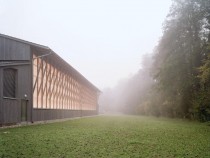
© Sebastian Schels
American engineer John Calvin Jureit obtained his first patent for the galvanised nail plate in 1956. Today, the connector plate, which is pressed into timber members using compressed air, is an essential component of many cost-efficient timber constructions.
In their sports hall in the upper Bavarian town of Haiming, Florian Fischer and Harald Fuchshuber raised this construction method to the level of a visible design principle. This new building in the centre of the town connects to an existing, much smaller school gymnasium. To keep the new hall as low as possible, it is recessed one metre into the ground. Two small end wings with single pitched roofs contain the locker, equipment and building services rooms and stiffen the building in the longitudinal direction.
The southern entrance facade rests on encastré reinforced concrete columns and also provides stiffening. A deep concrete lintel spans the wide but relatively low glazed openings. It is not obvious at first glance because its profile is very much like the timber post and beam panels above it. The remaining facade elements and the roof were prefabricated using Jureit’s nail plate technology.
In their sports hall in the upper Bavarian town of Haiming, Florian Fischer and Harald Fuchshuber raised this construction method to the level of a visible design principle. This new building in the centre of the town connects to an existing, much smaller school gymnasium. To keep the new hall as low as possible, it is recessed one metre into the ground. Two small end wings with single pitched roofs contain the locker, equipment and building services rooms and stiffen the building in the longitudinal direction.
The southern entrance facade rests on encastré reinforced concrete columns and also provides stiffening. A deep concrete lintel spans the wide but relatively low glazed openings. It is not obvious at first glance because its profile is very much like the timber post and beam panels above it. The remaining facade elements and the roof were prefabricated using Jureit’s nail plate technology.


